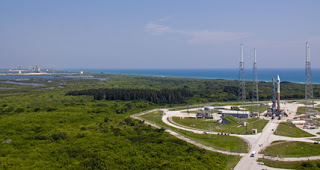 The latest Geostationary Operational Environmental Satellite, GOES-O, soared into space on June 27 after a successful launch from Space Launch Complex 37 at the Cape Canaveral Air Force Station in Florida.
The latest Geostationary Operational Environmental Satellite, GOES-O, soared into space on June 27 after a successful launch from Space Launch Complex 37 at the Cape Canaveral Air Force Station in Florida.The GOES-O spacecraft lifted off at 6:51 p.m. EDT on a Delta IV rocket. The National Oceanic and Atmospheric Administrations GOES-O satellite will improve weather forecasting and monitor environmental events around the world. The satellite is the second to be launched in the GOES N series of geostationary environmental weather satellites.
All indications are that GOES-O is in a normal orbit, with all spacecraft systems functioning properly, stated Andre Dress, GOES deputy project manager at NASAs Goddard Space Flight Center in Greenbelt, Md. We are proud of our support teams and pleased with the performance of the Delta IV launch vehicle.
Approximately 4 hours and 21 minutes after launch, the spacecraft separated from the launch vehicle. The Universal Space Network Western Australia tracking site in Dongara monitored the spacecraft separation.
On July 7, GOES-O will be placed in its final orbit and renamed GOES-14. Approximately 24 days after launch, Boeing Space and Intelligence Systems will turn engineering control over to NASA. About five months later, NASA will transfer operational control of GOES-14 to NOAA. The satellite will be checked out, stored in orbit and available for activation should one of the operational GOES satellites degrade or exhaust its fuel.
NASA contracted with Boeing to build and launch the GOES-O spacecraft. NASAs Launch Services Program at NASAs Kennedy Space Center in Florida supported the launch in an advisory role. NOAA manages the GOES program, establishes requirements, provides all funding and distributes environmental satellite data for the United States. Goddard procures and manages the design, development and launch of the satellites for NOAA on a cost-reimbursable basis.
For more information about the GOES-O mission and program, visit:



















